Sigma 120-300mm F2.8 DG OS HSM S Review

Introduction
The Sigma 120-300mm F2.8 DG OS HSM S is a fast telelphoto zoom lens for full-frame DSLR cameras, offering a constant aperture of f/2.8 throughout the focal range. It will also work with APS-C sensors with an effective increase in focal length. The Sigma 120-300mm F2.8 DG OS HSM S features a rounded 9 blade diaphragm which creates an attractive blur to the out of focus areas of the image, built-in optical image stabilisation, an Hyper Sonic Motor for fast and quiet autofocusing, and dust and splash-proof construction. The Sigma 120-300mm F2.8 DG OS HSM S lens is currently available for £3599.99 / $3599.99 in the UK and the US, respectively.
Ease of Use
Weighing in at a whopping 3390g and measuring 29cm in length, the Sigma 120-300mm F2.8 DG OS HSM S is a very big and heavy lens indeed, esepcially as that weight doesn't include the supplied tripod collar. As seen in the photos below, it dwarves even a full-frame camera like the Canon EOS 5D Mark III. This is not a lens that you can hand-hold for very long, being much more at home mounted on a sturdy tripod or monopod.
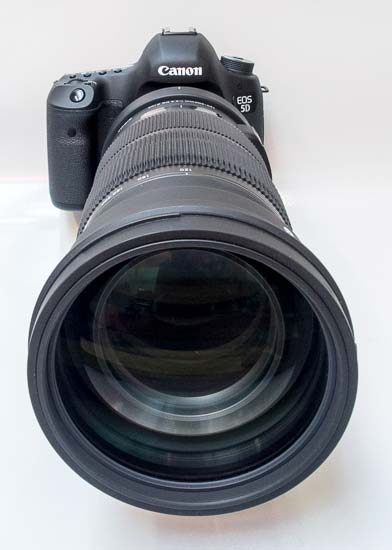 The Sigma 120-300mm F2.8 DG OS HSM S lens mounted on the Canon EOS 5D Mark III
The Sigma 120-300mm F2.8 DG OS HSM S lens mounted on the Canon EOS 5D Mark III
 The Sigma 120-300mm F2.8 DG OS HSM S lens mounted on the Canon EOS 5D Mark III
The Sigma 120-300mm F2.8 DG OS HSM S lens mounted on the Canon EOS 5D Mark III
 The Sigma 120-300mm F2.8 DG OS HSM S lens mounted on the Canon EOS 5D Mark III
The Sigma 120-300mm F2.8 DG OS HSM S lens mounted on the Canon EOS 5D Mark III
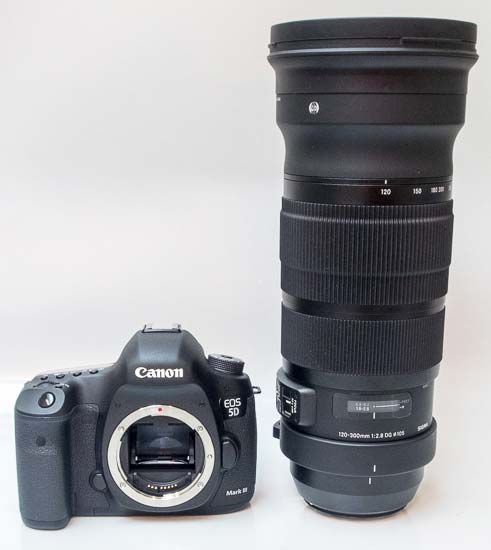 The Sigma 120-300mm F2.8 DG OS HSM S lens alongside the Canon EOS 5D Mark III
The Sigma 120-300mm F2.8 DG OS HSM S lens alongside the Canon EOS 5D Mark III
Build quality is excellent. The Sigma 120-300mm F2.8 DG OS HSM S lens has a part aluminium, part plastic shell with a mixture of metallic and plastic parts used inside. It also incorporates a brass bayonet mount that's supposed to be more durable. The optical elements are made of high-grade glass, while the lens has a dust and splash-proof construction.
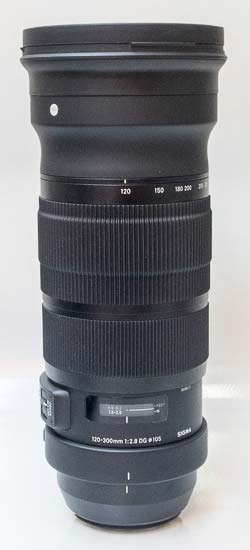 Side of the Sigma 120-300mm F2.8 DG OS HSM S lens
Side of the Sigma 120-300mm F2.8 DG OS HSM S lens
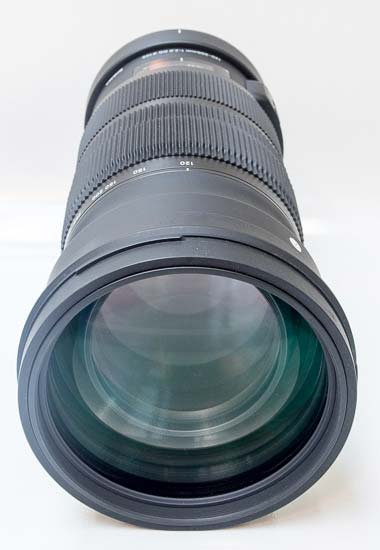 Front of the Sigma 120-300mm F2.8 DG OS HSM S lens
Front of the Sigma 120-300mm F2.8 DG OS HSM S lens
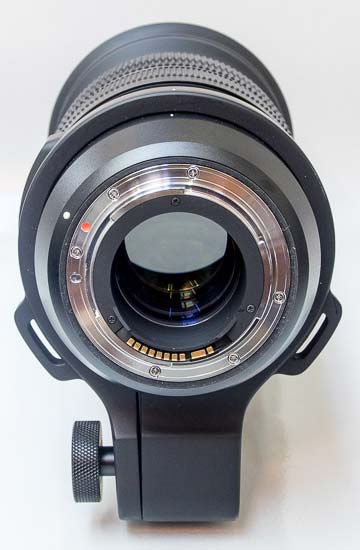 Rear of the Sigma 120-300mm F2.8 DG OS HSM S lens
Rear of the Sigma 120-300mm F2.8 DG OS HSM S lens
In terms of features, the Sigma 120-300mm F2.8 DG OS HSM S offers everything that you need from a professional telephoto zoom lens. This very usefully includes built-in Vibration Reduction, activated by the OS switch on the lens barrel, which offers around 4 stops of compensation. The OS system has two modes - mode 1 is suitable for general photography, and mode 2 is best for panning shots of moving subjects.
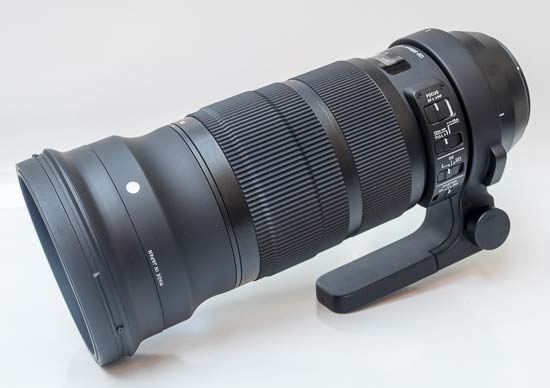 Front of the Sigma 120-300mm F2.8 DG OS HSM S lens
Front of the Sigma 120-300mm F2.8 DG OS HSM S lens
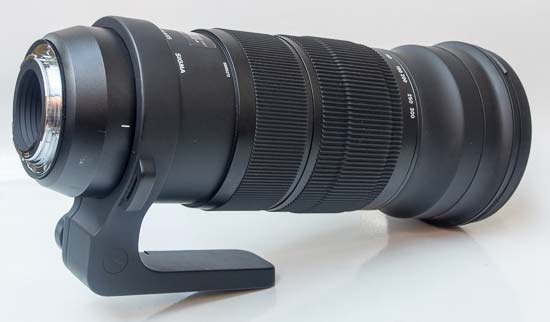 Rear of the Sigma 120-300mm F2.8 DG OS HSM S lens
Rear of the Sigma 120-300mm F2.8 DG OS HSM S lens
Focusing is usefully internal and manual focusing is possible when set via the Focus switch on the lens barrel. Full-time manual focus override is also available at any time simply by rotating the focus ring. The focus limiter switch has two settings, 10m-infinity and 1.5-2.5m-10m, which helps speed up the auto-focusing if you know how far your subject is from the lens. You can also use the USB dock to customise these ranges to your own needs. A clear distance scale in both feet and meters runs from the closest focusing distance of 1/5m / 4.9ft to infinity.
 The Sigma 120-300mm F2.8 DG OS HSM S lens in-hand
The Sigma 120-300mm F2.8 DG OS HSM S lens in-hand
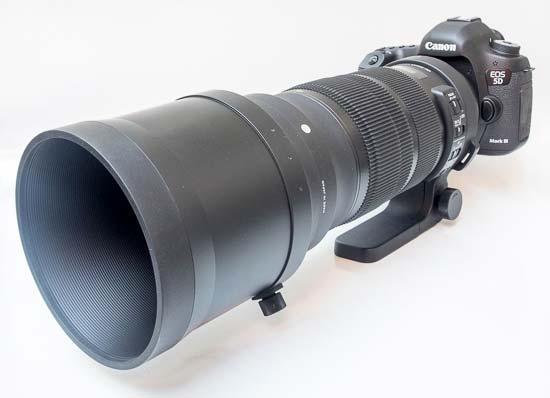 The Sigma 120-300mm F2.8 DG OS HSM S lens, with the supplied lens hood fitted
The Sigma 120-300mm F2.8 DG OS HSM S lens, with the supplied lens hood fitted
The Sigma 120-300mm F2.8 DG OS HSM S has a Custom Mode switch with three settings - Off, C1 and C2. Much like the Custom Settings on a camera body, you can use the provided software to tailor the lens settings (AF speed, focus limiter and OS functions) and then save them to the C1/C2 modes for easy recall via the Custom Settings switch.
The Sigma 120-300mm F2.8 DG OS HSM S ships with a good quality soft case and a massive metal circular lens hood (LH1220-01). It accepts 105mm filters.
Focal Range
At the 120mm focal length the angle of view is 20.4 degrees.
 Field of view at 120mm
Field of view at 120mm
At the 300mm focal length the angle of view is 8.2 degrees.
 Field of view at 300mm
Field of view at 300mm
Focusing
The Sigma 120-300mm F2.8 DG OS HSM S lens has a large focus ring, and it is ridged for easier grip too. There are hard stops at both ends of the range, making it easier to set focus at infinity. Polariser users should be pleased that the massive 105mm filter thread doesn't rotate on focus.
When it comes to auto-focusing, the Sigma 120-300mm F2.8 DG OS HSM S zoom is a quick performer, taking about 0.15 seconds to lock onto the subject when mounted on the Canon EOS 5D Mark III that we tested it with.
We didn't experience much "hunting", either in good or bad light, with the lens accurately focusing almost all of the time. It's also a very quiet performer, thanks to the built-in HSM (Hyper Sonic Motor), which makes this lens well-suited to video recording.
Chromatic Aberrations
Chromatic aberrations, typically seen as purple or blue fringes along contrasty edges, are only conspicuous by their complete absence from our test shots.
Light Fall-off
With the lens set to its maximum aperture of f/2.8, there is significant light fall-off in the corners at both ends of the zoom range. Stopping-down to f/5.6 virtually eliminates this. There's very little distortion to worry about.
 Light fall-off at 120mm
Light fall-off at 120mm
 Light fall-off at 300mm
Light fall-off at 300mm
Macro
The Sigma 120-300mm F2.8 DG OS HSM S isn't claimed to be a macro lens. It has a minimum focusing distance of 150cm / 59.1in and a maximum magnification ratio of 1:8.1 at the 200mm focal length. The following example demonstrates how close you can get to your subject, in this case a Compact Flash memory card.
 Close-up performance
Close-up performance
Bokeh
Bokeh is a word used for the out-of-focus areas of a photograph, and is usually described in qualitative terms, such as smooth / creamy / harsh etc. In the Sigma 120-300mm F2.8 DG OS HSM S lens, Sigma employed an iris diaphragm with nine rounded blades, which has resulted in very nice bokeh in our view. We do realise, however, that bokeh evaluation is subjective, so we've included several 100% crops for your perusal.
 |
 |
 |
 |
Sharpness
In order to show you how sharp this lens is, we are providing 100% crops on the following pages.
